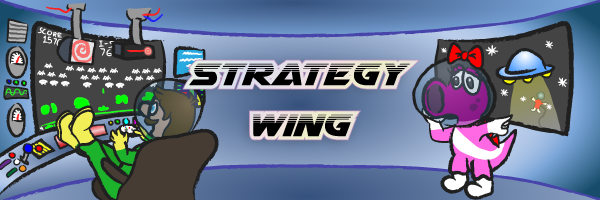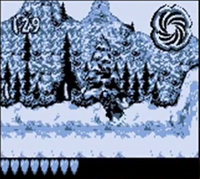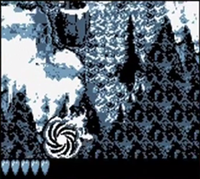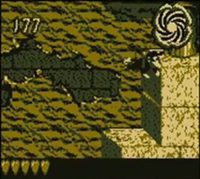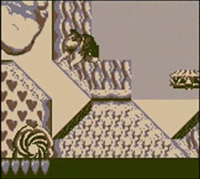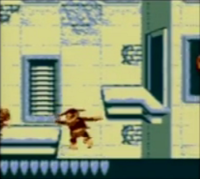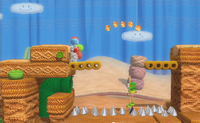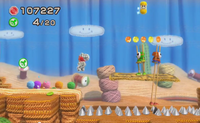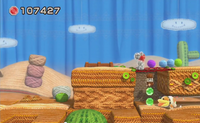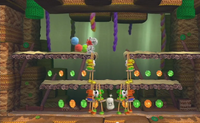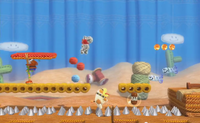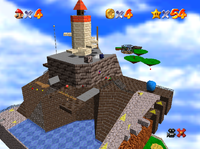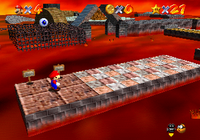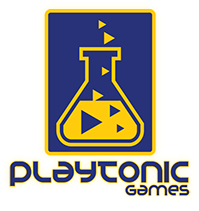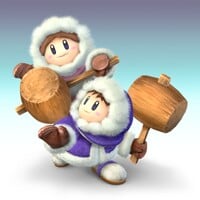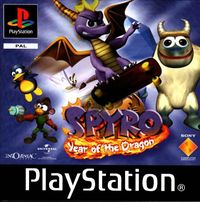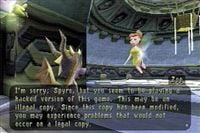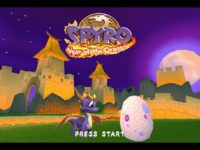The 'Shroom:Issue 100/Strategy Wing
Director's Notes
Written by: Stooben Rooben (talk)
Hello, 'Shroom readers, and welcome to the latest team to join The 'Shroom: Strategy Wing! I am very pleased to announce that I will be directing this new department; our goal is cover material related to tips, tricks, hints, cheats, guides, walkthroughs, and the analyses of video game history and mechanics. Since I have all this fancy Medic garb, I guess I should say, ve specialize in video game examinations! *snaps glove*
This team has been introduced in an effort to tidy up the organization of this paper's many sections, and what better issue to introduce it in than our biggest one yet? I still can't believe The 'Shroom has made it to Issue 100. It wouldn't have been possible without our readers, our writers, outstanding staff members, and of course, Mr. Director himself, Super Mario Bros. (talk). Without further delay, I will give you a rundown of whose sections you can expect to see here.
Firstly (but certainly not most importantly), I will be reclaiming my old position as writer for From the Mushroom Vaults. The last time I wrote that section was Issue 30, so I'm looking forward to covering games that have been released between then and now. Second, I would like to welcome Yoshi876 (talk) to the team! He will be writing a very cornerstone section, Mario Kart: Wheel Tips Corner. (Did you see what I did there with the adjective? Doy hoy hoy.) The next member I'd like to welcome to the team is Crocodile Dippy (talk), that Australian lass who heads Critic Corner. (Oh dear, another corner...) For Strategy Wing, she will be contributing a new section called Pocket Handbook; this section will highlight a variety of Pokémon tactics and strategies to benefit your play in the main game, or competitively. Finally, I'd also like to welcome long-time 'Shroom veteran Paper Yoshi (talk) to the team. His section, Mario Calendar, has been moved here to Strategy Wing as part of our historical analyses group.
I would also like to give very special thanks to the writers who contributed guest sections this month: Crocodile Dippy (talk) for submitting two addditional sections on her own, Let's Play Showcase and Pirates of the Gamer Plebians (the latter of which is a humorous analysis of anti-piracy measures in the video game industry); Tucayo (talk) for coming out of the woodwork and contributing the classic Beyond 120 Stars to this section; MrConcreteDonkey (talk) for his absolutely posh Beta Blockers submission; and finally, Super Mario Bros. (talk) and Crocodile Dippy (talk) for their very well-researched A History of Video Games.
I suppose that is it for Strategy Wing news this month. I just want to thank the staff for giving me this opportunity, and to thank every writer for their generous contributions this month. You all did awesome!
Now...prepare for your examination...
MCD discusses content that was removed from the final releases of Mario Kart 8 and Smash 4.
[read more]
Learn about Spyro: Year of the Dragon's anti-piracy measures!
[read more]
From the Mushroom Vaults
Written by: Stooben Rooben (talk)
Good day to you, 'Shroom readers! It's been a very long time since I've stood at this post — 70 issues to be exact! So, after nearly six years, I return to planet earthFrom the Mushroom Vaults. In this section, each month, I will be bringing you various tips, secrets, hints and cheats from Mario's games! After all this time, hopefully my entries will be longer than three sentences each. Here, I'll even stretch my introduction all the way to four.
Secrets: Donkey Kong Land (GB)
First up, since this month is pretty Rare-focused, I will be covering their Game Boy title, Donkey Kong Land. This is one of my absolute favorite games on the original Game Boy; it somehow manages to capture the feel of Donkey Kong Country's impressive graphics, has a decent length to it, and even has some useful features like saving and an extensive world map. The only areas I feel it's particularly lacking in are its camera (which, many times, will lead players into seemingly unintentional traps) and the ease of every boss battle. It's availabe on the 3DS Virtual Console, so I definitely recommend picking it up if you have the money. ...I'm not here to review the game though (Critic Corner might steal me away), so I will move on to the actual secrets I want to reveal.
In this portion, I will be focusing on the many secret exits located in this game. I'm not sure if I'm aware of them all, but there are at least five throughout the game that I know of. Some are fairly redundant and only serve as a means to access more bananas or Kong Tokens, while others can assist in speedruns or just save you from considerable aggravation.
The first of these secret exits is located in World 1-5, Rope Ravine. The one here is not difficult to find. Once the first main exit appears on the screen, you may notice that there is more land off to the right; if you continue to past the exit and jump over the "stairs", you will see two large groups of bananas. If you keep going right, you will eventually see the secret exit all the way in the top right.
The second secret exit is located in a much trickier level, World 1-9, Arctic Barrel Arsenal. This is easily the most difficult level of the first world, due to its heavy use of moving Barrel Cannons. However, there is a way to spare yourself from the time and frustration these kinds of levels can bring. There is a secret exit located towards the beginning of the level (before the first Letter K, even). When you see the second barrel in the level, you should notice that it is on a lower "stair" platform than the previous icy ground. By avoid this barrel (either by jumping around it, or by slowly falling before it and crawling past it), you can gain easy access to the secret exit by falling below the platform the barrel is on top of. The exit is very difficult to see if the camera is not positioned just right, so you may want to refer to the second screenshot from the left in the table below.
The third secret exit serves a similar purpose to the first; it is located in World 2-2, Kremlantis Kaos. As with the secret exit in Rope Ravine, you will have to travel past the main exit to find a "hidden" area. There will be a short wall to swim over; once you do, you should find a small collection of bananas and two Kong Tokens. At the top right of this small chamber will be the secret exit.
Secret exit number four is another secret exit designed specifically to spare players from a ridiculously difficult level, World 3-5, Sky High Caper. This level is a bit notorious among Donkey Kong Land players as the most difficult level in the game, largely because of its very awkward bouncy platform gimmick, but also because of its grand length. If you're just looking to beat the game quickly or wish to avoid the hassle of this convoluted level, you'll want to escape through the secret exit towards the start of the level. It is fairly well-hidden, but can be accessed by either falling straight down from the edge of the first cloud platform, or by adjusting the path of the nearby bouncy platform to show the secret exit in the game's camera. It's not hard to find, but you could die pretty easily trying to access it, so be careful if you don't want to lose a bunch of lives trying to skip this level.
The final secret exit is undoubtedly the most well-hidden out of all the ones I am covering. It's completely impossible to see, even after you use the exit; the only time you'll be able to see it is after you've used the exit and are heading back to the world map — the HUD on the bottom will briefly disappear during this transition and you'll see the secret exit spinning at the very bottom of the screen. This secret exit is located in World 4-5, Skyscraper Caper, the third-to-last level in the game. While the level itself is not overtly difficult, it does incorporate another weird gimmick like Sky High Caper that makes the level somewhat artificially difficult. The gimmick is a series of conveyor-belt-like ropes that force the Kongs to slide either up or down (and will greatly decrease their speed while climbing in the opposite direction); while this may not sound too difficult in writing, the ropes do make for a pretty annoying level when they are incorporated into narrow or enemy-crowded areas. However, you can bypass this level almost in its entirety by locating the secret exit hidden towards the beginning of the stage. The first platform that you start out on should have two ropes and a Gnawty. At the very edge of this platform, you can roll off, fall backwards and position yourself underneath the ledge's window. Remember that this exit is impossible to see, so either refer to the screenshot on the far right below, or check out this video.
| Rope Ravine The secret exit here can be located a short distance after the main exit. |
Arctic Barrel Arsenal The secret exit can be found just below the second barrel. |
Kremlantis Kaos Once again, the secret exit is located just after the main one. |
Sky High Caper The secret exit can be found right before the first bouncy platform. |
Skyscraper Caper The secret exit can be located below the ledge, right between the window in the background and the Gnawty walking on the platform. |
Unlockables: Yoshi's Woolly World (Wii U)
For the second portion of this section, I will be covering a small part of a game I have actually yet to play: Yoshi's Woolly World. This is a very bright, colorful and cute platformer that takes Yoshi's usual worlds and renders them entirely in yarn. I've watched quite a few gameplay videos and I can say that what I've seen has increased my relatively low interest in buying a Wii U. There are a couple reasons I am tackling this game despite not having played it previously: first, I wanted to cover material from a recent game; second, I wanted to cover a game that involves Poochy, the new mascot for The 'Shroom. I put two and two together, and arrived here. So, today, I will be explaining how to unlock Poochy Yoshi. It's a very simple process, but I feel it's worthy of discussing this month nonetheless.
As with all of Yoshi's alternate designs, you must collect five Wonder Wools in a single level to unlock Poochy Yoshi. The level from which you must collect these Wonder Wools is World 2-5, Spiky Stroll. Not by coincidence, this is a level that features Poochy; you will require his assistance to collect at least one of the Wonder Wool in this level. You may want to refer to the screenshots below to get a better of idea of where each Wonder Wool is specifically located.
The first Wonder Wool is located near the second Stilt Guy in the level. Underneath a platform near him is a hidden Winged Cloud that you must reveal; after breaking it, a white Wonder Wool will appear amidst a group of yellow and orange beads.
The second Wonder Wool can be found a short distance after the first Warp Pipe in the level. It is located rather high above a platform; reaching it will require you to jump on top of one of the nearby Stilt Guys or an incoming Gusty in order to gain enough height.
The third Wonder Wool is located in the second area of the level and will require Poochy's help to retrieve. After finding Poochy, you will find a high platform with breakable blocks on top of it; underneath a couple of those blocks, you'll find another platform with a brown Wonder Wool beneath it — you cannot access this little area yourself. You will need to break the block nearest to the edge so Poochy can jump up there. Once you have done so, you'll need to break most of the blocks after that point in order to squeeze yourself down to the path below; I recommend leaving enough blocks to allow Poochy to collect the nearby Smiley Flower, but once you have done that, try to lure him down to the path below. At that point, you will need to go back up to the upper path yourself to lead Poochy through the lower path. Along his way, he should collect all the green beads down there and fetch the brown Wonder Wool when he jumps on his way back up. He'll bring the Wonder Wool to you, allowing you to have collected the third one in the level.
The fourth Wonder Wool will require you to go through a Warp Pipe located roughly halfway through the third area of the level. You will reach a small canyon with a Stilt Guy and spikes all along the ground. At the beginning of this little canyon is a small group of Donut Blocks; if you stand on the first one long enough for it to drop, you can gain access to the Warp Pipe below. That Warp Pipe will take you to an underground room with six Stilt Guys guarding some green and orange gems, as well as another white Wonder Wool. Eliminate the Stilt Guys, collect the Wonder Wool, and use the Warp Pipe on the other side of the room to escape.
The fifth and final Wonder Wool can be located very near the end of the level. Long after the Lakitu appears, you'll run across Poochy once again in a small spike-covered canyon. To Poochy's right, beneath four Donut Blocks, you can find a brown Wonder Wool. To collect this, you can either ride Poochy to safely collect it (and really, why wouldn't you do that?), or you can risk collecting it by standing on the middle two Donut Blocks and grabbing the Wonder Wool as they fall. After this, you can make your way to the level's exit. Congratulations! You have unlocked the Poochy Yoshi design.
| The first Wonder Wool, which is white. You will need to activate a hidden Winged Cloud to see it. | The second Wonder Wool, which is yellow. You will have to jump on a nearby enemy in order to gain enough height to grab this one. | The third Wonder Wool, which is brown. You will require Poochy to collect it. | The fourth Wonder Wool, which is white. You will need to access a hidden area to find this one. | The fifth Wonder Wool, which is brown. This is probably the easiest one to grab. |
I suppose that concludes this month's edition of From the Mushroom Vaults. I hope you enjoyed it! I will see you next issue with all-new content. Happy reading!
Mario Kart: Wheel Tips Corner
Hello 'Shroom racers! Welcome to my first edition of Mario Kart Wheel Tips Corner, where I plan to give you just some extra tips to help you with your racing. So the lights are out, let's start racing.
Kool Karts
You can't race if you don't have a Kart to do it in, so in this section I'll give you some facts about a Kart, Bike or ATV that you can hopefully use for racing success.
This time, I have chosen the Cat Cruiser, why? Because it gives you absolutely no stat boosts whatsoever, you will have to rely purely on your own natural talent to race well using this one. However, this is a bit odd isn't it? Surely as a "Cat Kart" it should have some speed boosts.
Who you use the Kart with though, will some bearing though due to it offering no stat boosts. If you are a driver who favours acceleration over the other stats then characters like the babies and Lemmy Koopa are the characters that you want to be using. Do you favour speed over the other stats? Then you want to be using characters like Bowser, Wario]], Morton Koopa Jr. or Dry Bowser for your best results. You are not really favoured with this Kart if you choose characters who are of medium weight, but the lighter medium characters (Cat Peach or the Female Villager) do a have a similar traction to the heavier lighter characters (Lakitu, Shy Guy and others).
What's Changed?
Retro tracks are now a huge portion of the Mario Kart games, typically amounting to half the courses in the game. But usually these courses change some things up, so in this section I'll help you find out "What's Changed" in the retro tracks.
This issue we're going to look at what's changed in Ghost Valley 2. This track first appeared in Super Mario Kart, before returning in Mario Kart Wii, and there weren't that many changes. Boos were now given their updated look so they don't look that old (and they're also not visible at all time on the track), all the coins that used to litter the track were removed and, due to the removal of the Feather, a ramp was included at the location of the shortcut. It should also be noted that in Time Trials mode the blocks on the outskirts of the track don't fall off when hit, instead they fall as the driver continues racing around.
Ace Shortcut
In this small section I give you a way to shave a few seconds off your time, whether you know about it or not. Be warned, most of these shortcuts will require a Mushroom.
It's an obvious shortcut, but still. In the one of the opening corners you go round a flowerbed, simply use a Mushroom and you can cut the entire corner. Note this works for all the other flowerbeds in the course, and it also works in the Wii remake.
Pocket Handbook
Written by: Crocodile Dippy (talk)
G’day mates, starting a new permanent section here titled Pocket Handbook, for all you PokéNerds out there who want to know a little more about some wicked strats you can use to build your Pokémon teams. Well, not wicked strats. More like mostly unimpressive strats, really... but hey, with any luck, you’ll be able to learn something new from this and maybe it’ll help you in your Pokémon adventures, either the in-game story mode or in a more competitive setting. Just note that I'm primarily focusing on the Generation VI games (Pokémon X, Pokémon Y, Pokémon OmegaRuby, Pokémon AlphaSapphire), so if you got a problem with that, then you can take it up with me. You ever tried to go toe-to-toe with a pissed off Australian? Yeah, didn't think so. So let’s get moving with one of my favourite Pokémon; Mandibuzz!
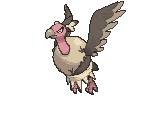
|
Name: | Mandibuzz | HP: | 110 | |
| Species: | Bone Vulture | Attack: | 65 | ||
| Type: | Dark | Flying | Defense: | 105 | |
| Abilities: | Big Pecks | Special Attack: | 55 | ||
| Overcoat | Special Defense: | 95 | |||
| Weak Armor | Speed: | 80 | |||
Mandibuzz is a really cool vulture Pokémon which evolves from Vullaby, whom serves as both the villainous and female counterpart to the Pokémon Braviary, being an exclusively female species that operates as an opportunistic hunter, seeking weak and battered prey from the skies, then ganging up on their target for an easy kill. While her playstyle in the game proper isn't quite so scavenging, per se, she is still centred around tiring out the enemy and limiting its growth potential for a long-winded take down. Mandibuzz is noted for her considerable resilience, with a tremendously high health pool on par with fellow tanks Reuniclus and Mamoswine, but coming out ahead by sporting much higher defensive stats to bolster its status as an immovable brick wall. Actually, "immovable" may be the wrong word to use since Mandibuzz also sports a shockingly decent speed stat for its position; yeah it won't be winning any marathons, and even moves slower than your average Abra or Diglett, but it can oftentimes be enough to piss off sluggish brutes trying to catch up to your tricks.
This allows Mandibuzz to take on a variety of utility roles, capable of removing stage hazards, forcing dangerous foes out of the fight or keeping helpless ones stuck with her, stalling to allow damage-over-time to do its thing, rendering the foes' items useless, or making crude faces at her foe to prevent them from setting up buffs. Herein lies my biggest problem with Mandibuzz; there's just too many bloody options to choose from! From that list alone are eight different moves, and that's not even all she can do, making the four-move limit a real pain in the ass when deciding what is the best structure for your darling little bone-picker. However, she has very low offensive stats, particularly her Special Attack, so relying on a direct approach is probably not the best idea with Mandibuzz. For my own Mandibuzz, affectionately named Shegor (because Psychonauts is fantastic, and you all absolutely should play it), I prefer to go with the following:
| Knock Off | Physical | The user slaps down the target's held item, and that item can't be used in that battle. The move does more damage if the target has a held item. |
| Toxic | Status | A move that leaves the target badly poisoned. Its poison damage worsens every turn. |
| Defog | Status | A strong wind blows away the target's barriers such as Reflect or Light Screen. This also lowers the target's evasiveness. |
| Roost | Status | The user lands and rests its body. It restores the user’s HP by up to half of its max HP. |
My rational behind this is that I prefer to play Mandibuzz in full turtle mode, frustrating the enemy by stalling them out for a long, painful death; I poison them with Toxic to ensure they'll take increasing damage each turn, while using Roost to taunt my foes further by inversely restoring Mandibuzz' health instead. Roost can also have the double use of dealing with Electric, Ice, and Rock type moves that might otherwise give Mandibuzz a rough time as, provided she moves faster than her opponent, she'll be able to lose her Flying typing for the rest of the turn. Knock Off is for item-dependent Pokémon that could hurl a spanner in the works if their items give them enough damage to smash through Mandibuzz's defenses or allow them to counterstall, and also provides Mandibuzz with some damage output, especially given the buff the move received this generation which will deal more damage if the enemy Pokémon was holding an item. Defog received a considerable buff in exactly what kinds of stage modifiers it's capable of removing from play, a step up from the rubbish HM it was in Generation IV, so I like to have it on hand as it will clear away stage hazards from your side of the field to deal with counterstallers or to dampen their defenses if I'm still planning on bringing a more combat-oriented Pokémon into the mix.

Toxic and Roost are essential for how I prefer to play Mandibuzz, but there are many other interchangeable moves you can go with. While my choice of Knock Off as my attacking move is one of the few direct combat moves Mandibuzz can gather some use from, Foul Play is also a decent choice if you're not overly concerned about the enemy's items, since it pools off the enemy's Attack stat while also factoring in the Same Type Attack Bonus (STAB) to give it that extra bit of "oomph". It does, however, require the enemy to actually have a physically-oriented fighter or two to make any use of it, and if it's against a Fighting or Fairy-type, then just forget it. Defog is useful for me since I never run stage hazards or barriers on my team if Mandibuzz is on-hand, but if your team relies on stage set-up as well or you're otherwise not too worried about your enemy's set-up, then you can trade this one out for Torment (to infuriate move spammers), Taunt or Whirlwind (to render buff set-up Pokémon useless), Mean Look (if you intend to keep a poor sucker stuck in the room with your slow slaughter), or Tailwind (if you feel your team needs some bonus speed to be of use). I wasn't kidding when I said you'll wish you had more than four move slots.
Mandibuzz's two possible standard abilities are both useful in their own ways, Big Pecks protecting her from most forms of Defense-reduction - certainly helpful for a tank like her - while Overcoat protects her from spore and powder-based moves, or weather damage like sandstorm or hail which can allow her to safely fit into weather-based teams if you're attempting to run the whittle-them-down strategy. I prefer the latter, honestly, since I still think this is Generation V so I continue to prioritise protection from the elements, but one thing's for sure; her Hidden Ability, Weak Armor, is bloody garbage since it'll reduce her defense to raise her speed whenever she's hit by a move that makes contact with her. That is just so useless to her. Her tanking abilities can be heightened by getting her to hold Leftovers as her Item, which will allow her to restore even more health over time to help her stay afloat from her opponent while they burn alive from the inside, while Rocky Helmet is when you want to go full troll as it'll damage the foe for a considerable amount of damage every time they make physical contact with Mandibuzz. It's kind of a dick move. In terms of type match-ups, Mandibuzz is a bit all over the place since while she carries two very good immunities, she has weaknesses to many of the common attacking types, while resisting mostly utility-leaned types. However, as mentioned earlier, Roost can nullify the weaknesses she has from her Flying-type, which can compensate to some degree provided your opponent is an unmoving statue.
| Weaknesses | Electric | Fairy | Ice | Rock |
| Resistances | Dark | Ghost | Grass | |
| Immunities | Ground | Psychic |
In the main game, Mandibuzz can seem a bit unappealing to more casual players, due to her meek fighting ability, lack of big flashy plays, annoyingly high evolution level, and her move type coverage will leave you wanting. However, in more serious play, Mandibuzz can be a very useful Pokémon that can take on a ridiculous amount of supporting roles, capable of infuriating her opponents while ensuring a safe playground for her more aggressive allies. She is, however, kept in check badly by basically any powerful Fairy-type Pokémon since they resist her only useful combat moves and don't even have the silver lining of Fighting-types of their STAB moves being nullified by Mandibuzz's Flying-type, which can make them a fairly safe way to switch out into her. She's also ironically undone by her own trick pony of stalling out poison damage, as she'll almost always lose out in a mirrored stalemate if her opponent has more combat potential; this is especially true of Florges, who can out-tank Mandibuzz while dealing considerably more damage to her in the process. Pokémon with the ability Magic Bounce - particularly Mega Sableye, who can out-troll her in basically every regard - can also become a problem, as they'll deflect all her Status moves right back at her; without these, she can do nothing to her opponent. But hey, if you want to try out a more methodical, patient playstyle, especially if you're the kind of person that likes to watch your opponent flail in agony and rage because at this point they don't care if they lose they just want the game to end, then Mandibuzz is the perfect gal for you.
Beyond 120 Stars
HI, readers! I'm your polygonal guest writer, Tucayo, here with Beyond 120 Stars, your source for everything Super Mario 64. So retro. Picture the next scenario: you're carelessly strolling through Bob-omb Battlefield, and then BAM! You're suddenly somewhere else. How does that even work? I most certainly don't know, but what I do know is the exact location for all of these "warp points", and how you can use them to your advantage. Remember most warp points work both ways, unless otherwise noted. I will give the instructions for how it would make more sense to use the warp. So plug your N64 back in, blow your SM64 cartridge, and let's get right to it! (or open your Virtual Console, which is honestly far less exciting).
- Disclaimer: All of these work in the N64 version. I assume they also do in the DS one.
- Course 1 - Bob-omb Battlefield: This world has two warp points. To get to the first one, as soon as you start the level head up the wooden ramp. Directly on your right you will see a patch of yellow flowers; standing near the middle of it will lead you to another patch of flowers, this one near the entrance to the mountain. There is not much practical use for this one, to be honest. The second warp point can be very useful for climbing the mountain quickly, especially when racing Koopa the Quick. To access this point, just climb the mountain up to the point where the cannonballs are coming out. Enter it and press against the wall on the back; this will teleport you to a similar opening right below the top of the hill.
- Course 2 - Whomp's Fortress: Make your way up the first part of the fortress, up to the point where the Thwomp and the Metal Cap are. Standing on the very corner of that area will warp you to a platform with a flag pole (that yields a 1-Up) pretty close to the top of the level. This is useful for stars 1 and 2, which require climbing the fortress.
- Course 4 - Cool, Cool Mountain: Right as you start the level go back to where the broken bridge is. Stand as close to the edge as possible and this will teleport you a similar bridge on the bottom of the mountain (man, this game loves mountains). From here you will clearly see a Red Coin and will have easy access to the very-annoying Mama Penguin.
- Course 7 - Lethal Lava Land: This particular one works best in only one direction if you're just starting the level. Make your way to the first island where you encounter Mr. I; after getting rid of him simply drop in the opening that will be left below where he was. This will teleport you to the island with the Wing Cap (which more easily accessed from the beginning of the level, to be honest). After dizzy-ing Mr. I to death you can use the warp point the other way with no inconveniences.
- Course 8 - Shifting Sand Land: From a hot course to a maybe even hotter one, Shifting Sand Land has two warp zones. The way the first one makes more sense is to go to where the Wing Cap on the maze is, by standing on the block to the left (if you have the end of the map behind you) of the Cap, Mario will be teleported to the palm tree near the oasis. This is a convenient way to easily get out of the maze; or, if used the other way round, this is an easier way to get to this Wing Cap and the nearby cannon. The second one is found inside the pyramid; after you climb the pole to get you from the second to the third floor, press the wall on your back (opposite to where the path is). This will lead you to a metal grille you had already seen before with a 1-Up on top. This warp is meant t be one way-only, but sometimes you may be able to travel back by standing on the very edge of the grid (but it's easier to just make your back on foot, to be honest).
- Course 10 - Snowman's Land: This one is kind of... uh... useless, that's the word. As soon as you start the course, make your way towards the first tree you will see on your right. Standing below it will lead you to a tree close to where the cold water. This can maybe save you like fifteen seconds of jumping through the course, so there's that.
- Course 11 - Wet-Dry World: For this warp, you have to make sure water is at its lowest level. In case you couldn't jump low enough into the painting, the Crystal Tap to drain most water is found below the ramp that takes you up the brown structure. Once you did this, make your way to the white stone structure with an Amp circling around it. Standing on the inner corner of the first step will take you all the way up to the cannon, making it possibly the warp point that saves you the most time and effort.
- Course 12 - Tall, Tall Mountain: Make your way to where the giant mushrooms with the Red Coins are. Now all you need to do is manage to stand on the smallest and shortest of them all. Standing right in the middle of it will teleport you to the tiny path leading to the cannon. This is needed to get Star #6.
- Course 13 - Tiny-Huge Island: For this warp point you need to be on Tiny Island (the painting on your left). Make your way to the ! Switch next to where the Piranha Plant and the Warp Pipe are. Hit the switch and make your way all the way to the floating island. Standing where the coin is will take you back to where the Pipe was. This only works one way, as it is your ticket out of that floating piece of land.
- Course 15 - Rainbow Ride: For this one, you need to get to the Big House in the Sky, which you do by taking a right on the spinning circles, and then taking another rate where the rainbow road splits. You can then drop on the balcony through which you enter the house. Standing on the edge of it will warp you to the top of the Red Coin maze, which has a ! Block with a 1-Up. Bear in mind there are strong winds in this area, so you need to stand still to use the warp point again. The warp point also works both ways, but it important to notice you'll pretty much be stranded whichever way you use it as the carpets will have disappeared. Your best choice is to try to jump to a platform below (remember to Ground Pound before hitting the ground!)
And that's it for this very helpful (or so I hope) section! I know you'll use this warp points for good. Until next time, then! Provided there IS a next time. For ANY of us. BYE!
Let's Play Showcase
Written by: Crocodile Dippy (talk)
Hey everyone, Dippy here once again to provide you with the very first Let’s Play Showcase, here to introduce you to promising Let’s Players and hopefully help get them going! For those who don’t know, Let’s Play is a form of video game walkthrough wherein a person records their own commentary over the game, with the intention of being informative, entertaining, comedic, or some amalgamation of each; many have partners to bounce commentary off of, others choose to go solo. Another form of Let’s Play exists called Scarecams, getting its name for players who placed live footage of their own face overlayed on the game footage to display live reactions to horror games, but is today more often used to provide a more personal approach to the audience. Today, we’ll be looking at one such type of Let’s Play from a bloke who has barely been doing videos for only six months, and a personal friend of mine offline; JohnnyBoy!
JohnnyBoy is a new kid on the block, an Australian gamer and taekwondo instructor who only recently started up his channel before Christmas last year, with a primary focus on PC gaming as many new Let’s Players do to start off. His first video was uploaded on December 23rd, 2014, which was a playthrough of Chicken Invaders 4, a series that ran for four videos before abruptly ending on a cliffhanger on February 11th, 2015. He redirected most of his focus during this time to his first large game project, which he started in his second video released on January 6th, 2015, beginning a long-term playthrough of Quake 4, the Quake game no one ever talks about. This Let’s Play has so far been his longest playthrough thus far, running for 26 until its finale video released on February 23rd, 2015, becoming his first finished playthrough; JohnnyBoy considers this one of his best Let’s Plays. In-between uploads of his Quake 4 LP, he made a habit of doing a few Fallout 3 videos which he did intend to be as long-running a series as possible, potentially as a cool off playthrough to relax from his more dedicated playthroughs; these are definitely worth watching if you want something more leisurely.
JohnnyBoy's first blind playthrough - meaning playing a game without any prior experience with the game - was for Evoland, starting on February 18th, one of the most charmingly honest playthroughs he's done as it displays his immediate reactions to the ever-changing style of the game as it cycles through the evolution and development of role-playing games over the decades. He's covered other indie titles in much shorter series or one-offs such as DLC Quest, Fists of Jesus, and Kung Fury, and he's also no stranger to covering games he feels are garbage such as Pac-Man and the Ghostly Adventures and Ampu-Tea. Currently, he's running long-term Let's Plays of LEGO Harry Potter (JohnnyBoy being a particularly big fan of LEGO games) and Tron 2.0, but has also begun other playthroughs of In Verbis Virtus and Saints Row: Gat Out of Hell. Fairly ambitious collection of works running at the moment, which does offer plenty of variety for your viewing pleasure, but also runs the risk of too many projects being left unfinished, too few being completed.
There are a few things you can say JohnnyBoy does right and wrong. His video and audio capture is brilliant, a step above many Let’s Players who try to use a camcorder to capture their game in one of the most aggravatingly inefficient methods of compensating for poor tech knowledge. The majority of the buggered up capture I’ve seen in his videos have been the fault of a poorly optimised game rather than his own software, and the only instance where the audio seemed to glitch up was on his Pac-Man video, which is more than can be said for many upstart Youtube Let’s Players who feel like they can put anything up on their channel and get away with it. He also tries his best to avoid inserting political commentary either which way into his videos, aside from a slip up in his first Chicken Invaders 4 video that he swiftly apologises for. His commentary, however, is fairly bog-standard, and has a tendency to ramble on at times even during dialogue-driven cutscenes which can damage the impact of story-focused games and cause information overload for the viewers with the constant stream of commentary. Likewise, the informativeness and humour of his commentary can be a bit hit or miss - it's not really my place to suggest anything, but many Let's Players will tend to work off a base script and ad-lib commentary from there, which often helps keep things on track and more easily manageable.
Now yes, commentary is one of the big things about Let's Play - it's what separates a Let's Play from a standard longplay walkthrough of a game, after all - but see, the thing that I feel makes JohnnyBoy worth your time is just how earnest he is. Many Let’s Players, such as Pewdiepie or Angry Joe, sell themselves off a manufactured persona constructed specifically to garner views, almost akin to a brand name more than an actual person; JohnnyBoy, on the other hand, is more comparable to the blokes at Game Grumps or his own idol Markiplier, whom present themselves as they are to the audience with little sugar-coated phoniness. Maybe he tends to exaggerate his mannerisms sometimes, but there’s still a feeling of humanity there, like JohnnyBoy is just another gamer out there who loves games, and wants to spread their joy around with everyone, not someone who is in this to make a quick buck and scream at things. Many of the issues he has can be improved over time; a better developed knowledge of recording and editing etiquette, a matured sense of observation, improved ad-libbing ability while maintaining informative and entertaining commentary, etc. But you can’t fix a rotten personality, and that’s something that JohnnyBoy, for all his vulgarities, can’t be faulted for, which is why I feel he deserves an honest opportunity... and besides, you Americans love our Aussie accents! As he once said to me:
- I don't really have any plans for games, except more LEGO games, I love LEGO. The only thing I'm hoping for, for the future of the channel, is to gain subscribers so I can make more people happy. All I've ever wanted to do is make people smile and laugh.
- ~JohnnyBoy
Ultimately, JohnnyBoy is just getting started. He's trying to find his Let's Play identity and establish a style all to his own, and if you can understand that much, he's a genuinely kind-hearted person who fully intends to get as involved with his fanbase as possible, as soon as it starts to materialise; if you want to be there to help him along in that journey and be apart of it, then check out his Youtube channel, as well as his social networking pages in the table to the side, and give him some support!
A History of Video Games
Written by: Super Mario Bros. (talk) (edited by Crocodile Dippy (talk) and Stooben Rooben (talk))
- "We've been making golden memories and redefining gaming genres since 1985, and that's not about to change. Everything we do is true to our goals of pursuing new experiences and putting players first. Still ahead of the game after three decades of evolution, there's no other studio in the world quite like Rare."
— Rare[1]
Rare Ltd., commonly referred to as Rare, is a British video game developer considered by many to be among the most legendary in the industry. The quirky studio has contributed best-sellers and highly acclaimed entries to a wide variety of genres across both Nintendo and Microsoft platforms for the past 30 years. The small team has gained a reputation for being innovative and resourceful, and has brought together many talented individuals throughout its history who are either still with the company or have moved on to work on their own projects. Needless to say, Rare has easily become one of the most influential actors on the gaming stage; the team has consistently pushed hardware and software to its fullest limits to create charming games that are anticipated and played by people around the world.
Ashby Computers & Graphics Ltd.
To truly understand Rare as it is today, where their work ethic developed, and how they rose to the top, one must start by looking at its humble beginnings as a small family business. Having grown tired of programming arcade games and lacking complete control of their creative output, brothers Chris and Tim Stamper formed Ashby Computers & Graphics, alongside John Lathbury and Carole Ward, in 1982. The brothers’ new company developed games for the home market; specifically, they started programming games for the Sinclair ZX Spectrum, a personal computer which was popular in the United Kingdom at the time. The duo worked long hours and even through most holidays (save for two Christmas days) in order to create quality games; their first release, Jetpac, was both a critical and a commercial success and a string of hit games followed shortly after. Rather than publishing their games under the Ashby name, however, they instead used their more personable and relatable trade name: Ultimate Play The Game.[2][3][4][5][6][7]
The Stampers brothers could have easily become comfortable with what they were doing and continue making hit games for the ZX Spectrum[8]; however, seeing an opportunity to create bigger and better games for an international market as well as protect their games from piracy, they decided to shift gears toward developing titles for the Nintendo Entertainment System in 1985. They, alongside Joel Hochberg from the United States, decided to form a new division within Ashby dedicated to dissecting the Japanese gaming company’s hardware in order to better understand how to utilize the system to create quality games. After Ultimate and the newly-formed studio, Rare Ltd., collaborated on a few more games for the British personal computer, the Stampers brothers shocked the public by selling off its older company to invest solely in their output for Nintendo. At the time, Nintendo restricted its third-party developers to a limited amount of games it was allowed to produce for the system in a given year as a quality-control measure. Rare, however, impressed Nintendo with its products and was granted an unlimited license to release as many games as they wanted – leading to classics such as Wizards & Warriors, Battletoads, and R.C. Pro-Am.[9] This move would indicate the beginning of a long and lucrative partnership between the two companies that would fully take root in 1994.[10][11][12][13][14][15]
Nintendo
By the early 1990s, Rare solidified itself as one of Nintendo’s key developers, and upon the release of the Super Nintendo Entertainment System, they had decided to invest their profits from their NES games into expensive Silicon Graphics workstations in order to create 3D-rendered games. Nintendo, after seeing the success of Killer Instinct and the progress of 3D prototypes that were being developed, purchased a 49% stake in the company and offered their entire catalogue for the team to make a game from. They chose to create a game called Donkey Kong Country, which became one of the highest selling games for the SNES and allowed Rare to expand the series’ universe.[16] Several sequels within the Donkey Kong series were developed, and other projects, such as Project Dream and a James Bond rail shooter, were beginning to take shape and eventually evolved into some of the most iconic games that would be featured on the Nintendo 64.
Some of Rare’s most endearing and revolutionary works saw their release on the Nintendo 64, taking full advantage of advanced hardware and the 3D environments and detailed graphics that could be created at the time. Shifting some of their late SNES projects to the N64, the James Bond rail shooter turned into the free-roaming GoldenEye007 and revolutionized the way shooters worked by adding a diverse set of objectives, mapping different proportions of damage taken to different parts of the body, and extensive multiplayer options, among others. Project Dream also turned into a Super Mario 64-like platformer and changed extensively during its development. Originally about a boy named Edison and his friends taking on the pirate Captain Blackbeard, the focus shifted to a honey bear named Banjo and his sidekick, a red bird named Kazooie. These concepts proved to be extremely successful, and platformer and shooting games became a staple of Rare’s during this time period: Perfect Dark, Banjo-Tooie, Jet Force Gemini, and Conker’s Bad Fur Day were released in the years that followed, all of them earning large followings and praise from gaming critics.[17][18] The team also had its sights set on the racing genre, too. The most notable of these titles was Diddy Kong Racing, which starred Donkey Kong’s buddy from Donkey Kong Country; Diddy Kong and friends must race against the evil Wizpig in order to restore peace to their island. The game was another success story, and Rare obtained a license from Disney to create two Mickey Mouse racing games: Mickey's Racing Adventure and Mickey’s Speedway USA.[19]
Microsoft
The successful Nintendo 64 era came to a close in 2001, as Nintendo rolled out the new Gamecube system, with it being Nintendo’s foray into disk gaming. Rare was hard at work with a number of new projects for Nintendo’s new system, including sequels to Banjo-Tooie, Conker’s Bad Fur Day, Perfect Dark, and Diddy Kong Racing. Additionally, several new projects, such as Dinosaur Planet[20] and Kameo: Elements of Power were being planned as new franchises to be introduced. Shigeru Miyamoto, looking at the amount of similarities between the main character of Dinosaur Planet and another one of his own series, recommended that the project be made into an entry of the StarFox series. This would become Star Fox Adventures, and ultimately, the last project Rare would develop while under their partnership with Nintendo. In 2002, shortly after the game was released, Microsoft announced that it had bought the game developer for $375 million and would be incorporating it as one of their major game creators.[21] Due to the sale, several projects were either cancelled or overhauled in order to transition to making games for the Xbox.
Despite Rare’s acquisition by Microsoft, the studio struck a publishing deal with THQ and mostly produced Game Boy Advance games in the early transition period as only Nintendo and Sony were involved in the handhelds market at the time.[22] Two Banjo games were released on the handheld (including one that initially started as a Diddy Kong Racing spin-off), as well as a Sabre Wulf and It’s Mr. Pants (also a retooling of a Donkey Kong puzzle game). Additionally, they worked on porting the Donkey Kong Country games to the system, which Nintendo published.[23] For the Xbox, Grabbed by the Ghoulies and Conker: Live and Reloaded were released, both to mixed reviews[24]. Chris Seavor (the creator of the two Conker games) himself is even quoted as saying, “There’s no doubt in my mind, that had everyone taken a step back, including myself and said ‘What are we doing here..?’ if at that point everyone agreed another Conker game was to be made, the question should have been asked.. ‘Why the fuck aren’t we doing the sequel then instead?’”[25] All other projects that Rare had planned on doing at the time were then postponed to the Xbox 360.
Kameo: Elements of Power and Perfect Dark Zero were both released as Xbox 360 launch titles in 2005 and were received positively.[26] Viva Piñata was released in 2006 and received a sequel the following year, both of which were also received positively. At the end of 2006, the Stampers brothers left Rare in order to pursue other opportunities, and although speculation that low sales figures prompted their departure, they have maintained that was not the case.[27] In 2008, the new Banjo game was released and was a significant departure from its predecessors. Reviewers generally accepted the game, but it received backlash from fans who were expecting a more traditional entry in the series. Despite Rare’s output for Microsoft generally being received well by critics and fans alike, sales continued to drop lower and Microsoft reorganized the studio to focus mainly on developing the avatars and games for the Kinect peripheral.[28]
Current
In between development for the Kinect platform, a third Killer Instinct game was released that rebooted the series for Xbox One. The game itself was received well, but was criticized for the initial lack of content until updates were provided. A third Kinect Sports game also saw release on the new platform. Even though its predecessor, Kinect Sports, was hugely successful, selling upwards three-million units[29], Kinect Sports Rivals was a commercial and critical flop and resulted in Microsoft conducting mass layoffs and refocusing the software team again.[30] In the meantime, several staff members had left the company in order to start their own teams. Gory Detail was formed in 2012 by Chris Seavor, the mastermind behind Conker's Bad Fur Day, and is currently working on The Unlikely Legend of Rusty Pup. Playtonic Games was formed in 2015 by Chris Sutherland and other important former Rare employees; they have started developing Yooka-Laylee, a spiritual successor to the Banjo games which they originally created. After refocusing the team in 2015, Rare itself is currently working on Rare Replay, a compilation of its old works; and Sea of Thieves, a reimagining of the Project Dream concept of the 1990s into a MMO-adventure pirate game, which have already drummed up increased interest in the company and the Xbox One console overall. Time can only tell how well that interest will translate to sales, and we wish Rare nothing but the best in all their future endeavors.
References
- ^ "Rare Ltd. - Creators of Rare Replay and Sea of Thieves". Rare Ltd. - Creators of Rare Replay and Sea of Thieves. Retrieved 17 July, 2015.
- ^ McLaughlin, Rus. 28 July, 2008. "IGN Presents the History of Rare". IGN. Retrieved 17 July, 2015.
- ^ "Ultimate Play the Game". Centre for Computing History. Retrieved 17 July, 2015.
- ^ Maher, Jimmy. 14 January, 2014. "The Legend of Ultimate Play the Game". The Digital Antiquarian. Retrieved 17 July, 2015.
- ^ Philedius. 16 September, 2014. "Rare, Ltd.". Giant Bomb. Retrieved 17 July, 2015.
- ^ "The Best of British". CRASH - The Online Edition. Retrieved 17 July, 2015.
- ^ "Ultimate Play the Game: A potted history". Robsoft Cloud. Retrieved 17 July, 2015.
- ^ Jagged85. 20 February, 2013. "ZX Spectrum". Giant Bomb. Retrieved 17 July, 2015.
- ^ "Computing Games published by Ultimate Play the Game". Centre for Computing History. Retrieved 17 July, 2015.
- ^ McLaughlin, Rus. 28 July, 2008. "IGN Presents the History of Rare". IGN. Retrieved 17 July, 2015.
- ^ "Ultimate Play the Game". Centre for Computing History. Retrieved 17 July, 2015.
- ^ Maher, Jimmy. 14 January, 2014. "The Legend of Ultimate Play the Game". The Digital Antiquarian. Retrieved 17 July, 2015.
- ^ Philedius. 16 September, 2014. "Rare, Ltd.". Giant Bomb. Retrieved 17 July, 2015.
- ^ "The Best of British". CRASH - The Online Edition. Retrieved 17 July, 2015.
- ^ "Ultimate Play the Game: A potted history". Robsoft Cloud. Retrieved 17 July, 2015.
- ^ "History of Donkey Kong Country". Donkey Kong Megasite. Retrieved 17 July, 2015.
- ^ "Rare, Company Info and List of Games". IGN. Retrieved 17 July, 2015.
- ^ Eaton, Anthony. 23 December, 2000. "Special: The History of Rareware". Rare Shooters. Retrieved 17 July, 2015.
- ^ "Rare, Company Info and List of Games". IGN. Retrieved 17 July, 2015.
- ^ IGN Staff. 26 January, 2001. "Dinosaur Planet". IGN. Retrieved 17 July, 2015.
- ^ Boulding, Aaron. 24 September, 2002. "Microsoft Buys Rare". IGN. Retrieved 17 July, 2015.
- ^ Harris, Craig. 7 November, 2002. "Rare Still on For GBA". IGN. Retrieved 17 July, 2015.
- ^ IGN Staff. 11 August, 2003. "Rare Line-Up Revealed". IGN. Retrieved 17 July, 2015.
- ^ Goldstein, Hilary. 17 June, 2005. "Conker: Live and Reloaded". IGN. Retrieved 17 July, 2015.
- ^ "Chris Seavor: 'Nowadays, Conker would be impossible.'". Gamikia. Retrieved 17 July, 2015.
- ^ "Perfect Dark Zero review". GameSpy. Retrieved 17 July, 2015.
- ^ Smith, Luke. 02 January, 2007. "Rare Founders Leave to 'Pursue Other Opportunities'". http://1up.com Retrieved 17 July, 2015.
- ^ Reynolds, Matthew. 28 October, 2010. "Rare: 'Kinect will be our main focus'". Digital Spy. Retrieved 17 July, 2015.
- ^ Gamespot Staff. 12 May, 2011. "Xbox 360 tops April console sales, Kinect library to triple in 2011". Gamespot. Retrieved 17 July, 2015.
- ^ Parfitt, Ben. 19 May, 2014. "Layoffs at Rare following Kinect Sports Rivals sales disappointment". The Market for Computer & Video Games, UK. Retrieved 17 July, 2015.
Mario Calendar
Written by: Paper Yoshi (talk)
In memory of Satoru Iwata (Sapporo, Hokkaido, Japan; December 6th, 1959 – Kyoto, Kyoto, Japan; July 11th, 2015) and Jules Bianchi – former F1 driver for the Marussia F1 Team (Nice, Provence-Alpes-Côte d'Azur, France; August 3rd, 1989 – July 17th, 2015)
Hello there, and welcome to this month's issue of Mario Calendar!!
Unlike most of the time, I actually have news regarding this section, so let's get to that.
This is a special month for The 'Shroom, as we release its 100th issue, and special issues deserve very special news. Having been a proud member of the Core Staff for a total of 30 issues (Pipe Plaza Director from Issue LXI to Issue XC), I am very pleased to announce that Mario Calendar will be moved to our newest team, the Strategy Wing Team, starting this issue, as part of the paper's restructuring.
However, unfortunately for us and for the gaming industry, I have some bad news to deliver as well. Satoru Iwata, CEO of Nintendo, passed away on July 11th due to complications with a bile duct tumor. I obviously wasn't close to Iwata-san, but, just by watching him in E3 presentations and Nintendo Direct videos, I could tell that he truly loved what he did. He deeply cared about Nintendo, and, when things went bad in 2013 (please correct me if I'm wrong), he went as far as to take himself a massive pay cut – something he would not do if he didn't love the company. Thank you for all you did for Nintendo and for the gaming industry, Mr. Iwata, a true gamer at heart. You'll be missed by us.
I guess that's all for this issue's news, so let's check all the Mario, Yoshi, Wario and Donkey Kong games released on a July day, which are the following:
| Abb. | Console/Store |
|---|---|
| NES | Nintendo Entertainment System |
| SNES | Super Nintendo Entertainment System |
| N64 | Nintendo 64 |
| GCN | Nintendo GameCube |
| Wii | Nintendo Wii |
| Wii U | Nintendo Wii U |
| GB | Game Boy |
| GBC | Game Boy Color |
| GBA | Game Boy Advance |
| NDS | Nintendo DS |
| 3DS | Nintendo 3DS |
| WiiVC | Wii Shop - Virtual Console |
| 3DSVC | Nintendo eShop (3DS) - Virtual Console |
| WiiUVC | Nintendo eShop (Wii U) - Virtual Console |
| Abb. | Region |
|---|---|
| NA | North America |
| JP | Japan |
| EU | Europe |
| AU | Australia/New Zealand |
| KO | Republic of Korea |
| CN | People's Rep. of China |
| HK | Hong Kong, China |
| TW | Republic of China (Taiwan) |
- July 1st
- 1987 (AU): Super Mario Bros. (NES)
- 1992 (AU): Super Mario World (SNES)
- 1999 (EU/AU): Super Mario Bros. Deluxe (GBC)
- 2004 (JP):
- 2010 (AU): Super Mario Galaxy 2 (Wii)
- July 2nd, 2007 (NA): Super Mario Bros. 2 (NES-WiiVC)
- July 3rd
- 2010 (HK/TW): New Super Mario Bros. Wii (Wii)
- 2014 (NA): Mario Tennis: Power Tour (GBA-WiiUVC)
- July 4th
- 1984 (JP): Donkey Kong 3 (NES)
- 2005 (CN): WarioWare, Inc.: Mega Microgame$! (iQue GBA)
- July 5th, 2012 (NA): NES Open Tournament Golf (NES-3DSVC)
- July 8th, 2010 (KO): Mario & Luigi RPG: Partners in Time (NDS)
- July 9th
- 1993 (JP): Yoshi no Cookie (SNES)
- 2007 (NA): Yoshi (NES-WiiVC)
- July 10th
- 2004 (EU):
- 2007 (JP): Mario Story (N64-WiiVC)
- July 11th
- 2003 (JP): Super Mario Advance 4: Super Mario Bros. 3 (GBA)
- 2013 (NA): Super Mario Bros. 2 (NES-3DSVC)
- July 12th, 2013 (EU): Mario & Luigi: Dream Team Bros. (3DS)
- July 13th
- 2007 (EU/AU): Paper Mario (N64-WiiVC)
- 2013:
- (JP): New Super Luigi U (Wii U)
- (AU): Mario & Luigi: Dream Team Bros. (3DS)
- July 14th
- 1992 (JP): Mario Paint (SNES)
- 1993 (JP):
- Super Mario All-Stars (SNES)
- Yoshi's Safari (SNES)
- 2005 (JP): Dance Dance Revolution with Mario (GCN)
- 2007 (KO): WarioWare: Touched! (NDS)
- 2008 (NA): Donkey Kong 3 (NES-WiiVC)
- 2011:
- (EU/AU): Mario's Picross (GB-3DSVC)
- (NA): Game & Watch Gallery (GB-3DSVC)
- July 15th
- 1983 (JP):
- Donkey Kong (NES)
- Donkey Kong Jr. (NES)
- 2013:
- (JP/NA/EU): Donkey Kong (NES-WiiUVC)
- (JP): Donkey Kong Jr. (NES-WiiUVC)
- 1983 (JP):
- July 16th
- 2007 (NA): Paper Mario (N64-WiiVC)
- 2014 (JP): Super Mario Advance (GBA-WiiUVC)
- July 17th, 2008 (KO): Super Mario Bros. 2 (NES-WiiVC)
- July 18th, 2013:
- (JP): Mario & Luigi RPG 4: Dream Adventure (3DS)
- (KO): Luigi's Mansion: Dark Moon (3DS)
- July 19th
- 2002 (JP): Super Mario Sunshine (GCN)
- 2007 (AU): Mario Party 8 (Wii)
- 2009 (CN): New Super Mario Bros. (iQue DS)
- 2012 (EU/AU): Wario Land II (GBC-3DSVC)
- July 21st
- 2000 (JP): Mario Tennis 64 (N64)
- 2001 (JP): Mario Kart Advance (GBA)
- 2005 (JP): Mario Superstar Baseball (GCN)
- 2011 (EU/AU): Game & Watch Gallery (GB-3DSVC)
- July 22nd, 2004 (JP): Paper Mario RPG (GCN)
- July 23rd (JP):
- 2008: Donkey Kong 3 (NES-WiiVC)
- 2014: Mario vs. Donkey Kong (GBA-WiiUVC)
- July 24th (JP):
- 2007: Mario Open Golf (NES-WiiVC)
- 2008: Wario Land Shake (Wii)
- 2013: Mario & Donkey Kong: Mini Mini Carnival (3DS) – Nintendo eShop
- 2014: Yoshi's New Island (3DS)
- July 25th, 2012 (JP): Super Mario Bros. 2 (NES-3DSVC)
- July 26th
- 1999 (NA): Mario Golf (N64)
- 2007:
- (JP): Mario Party 8 (Wii)
- (KO): Super Mario 64 DS (NDS)
- 2012 (NA): Wario Land: Super Mario Land 3 (GB-3DSVC)
- 2013:
- (EU): New Super Luigi U (Wii U)
- (HK/TW): Luigi Mansion 2 (3DS)
- July 27th
- 1990 (JP): Dr. Mario (NES & GB)
- 1995:
- (JP): Donkey Kong Land (GB)
- (EU): Mario's Picross (GB)
- 2006 (JP): Mario Basketball 3on3 (NDS)
- 2011 (JP): Dr. Mario (GB-3DSVC)
- 2013 (AU): New Super Luigi U (Wii U)
- July 28th
- 2003 (NA): Mario Golf: Toadstool Tour (GCN)
- 2006 (JP): Game & Watch Collection (NDS)
- 2012 (JP): New Super Mario Bros. 2 (3DS)
- July 30th, 2007 (NA): Mario Strikers Charged (Wii)
- July 1992 (NA): Yoshi (GB)
And that concludes our list for this month. We'll meet again next month.
Beta Blockers
Written by: MrConcreteDonkey (talk)
Hey, MCD here, and welcome to Beta Blockers, where we look at removed content in video games! Originally I did this as a part of Critic Corner's Should Have Been, but this has been moved here so there's more content for the new team and whatnot.
As with Should Have Been, today I'm covering Mario Kart 8 and Super Smash Bros. for Nintendo 3DS / Wii U.
Mario Kart 8
Firstly, an early idea for this game's gimmick (which ultimately ended up being "screw gravity!") was for drills to be attached to players' karts, so they could tunnel through the ground. Ultimately, however, that was decided to be too boring.
Four unused tracks have been found in the game's files:
- The first, "Gu_Menu", is just a large floating square - no minimap, item boxes, checkpoints, route data. As it doesn't clean the screen in between render frames, anything on the screen stays there until it's overwritten. You can also play this exciting new track in a VS Race, though the CPUs don't do much. Upon falling off the stage, you just respawn, without help from Lakitu. Funnily enough, you can get MKTV highlights on this track. Here's a video of it in action.
- The second, "Test", is a copy of the Flower Cup's Mario Circuit without music. As Mario Circuit was the first course designed in the game, and judging by the name, this was probably used for testing.
- The third, "ReservedXX", crashes the game.
- The fourth, "UnderConstructionXX", also crashes the game.
Additionally, there are four unused track icons, depicting a Yoshi Egg, a Shine Sprite, a Boo and a Spiny Shell. An updated version of the Yoshi Egg icon was used in the Legend of Zelda x Mario Kart 8 DLC pack's Egg Cup (lol), so maybe the other three will also turn up in future. Also, pink and green-coloured Toads were meant to appear in crowds on courses such as Rainbow Road, but ultimately didn't.
A lot of differences can also be seen in earlier builds of the game, though these are mostly minor. For example, the E3 2013 build of the game did not yet have a fully orchestrated soundtrack, so the instrumentation was slightly different. Triple Bananas stayed in a line behind the kart (instead of circling around it) and were obtainable in first place. The sound made by the item roulette was different, and the Bullet Bill, Spiny Shell, Super Star, and Lightning were unavailable in this demo. Twisted Mansion was known as "Boo House", and the Goomba Towers in Mario Circuit were higher and harder to avoid. And so on. A lot of minor changes. Nothing too interesting.
Super Smash Bros. for 3DS/Wii U
The Ice Climbers were originally intended to be in the game - there's even, like, a cheer for them and everything. They worked perfectly on the Wii U, but caused framerate issues on the 3DS, so therefore had to be removed, as Sakurai wanted to keep the roster for both games the same. Also, in terms of characters, Dr. Mario, Dark Pit and Lucina were all intended to be alternate costumes for Mario, Pit and Marth, respectively - however, Sakurai decided to split them so he could give them alternative characteristics to make them different from their counterparts. Takamaru from The Mysterious Murasame Castle and Heihachi from Tekken were also considered as characters, but the former became an Assist Trophy and the latter a Mii Fighter outfit.I'm going to go a little off-topic for a minute here. Certain pre-release rumours about the game, known as the 'Gematsu leaks', stated that among the new playable characters in the series would be the Villager, Wii Fit Trainer, Mega Man, Little Mac, Pac-Man and Miis would be playable in the game, and revealed at E3 2013. Many of these, especially Wii Fit Trainer, were unlikely choices - however, the first three were revealed at E3 2013 (and Little Mac a while later). After the Direct that revealed Little Mac, the leaker reinforced their claim that Pac-Man and Miis were playable, and also predicted Shulk, Palutena, Chrom from Fire Emblem: Awakening, the Chorus Kids from Rhythm Heaven and a Pokémon from Pokémon X and Y. These were later reinforced by the leaker a day before E3 2014, in which Greninja, a Pokémon from X and Y was revealed. However, after a July 2014 Nintendo Direct, in which Robin and Lucina were revealed (and Chrom was deconfirmed), the leak was generally assumed to be false, as Chrom was not playable, and it had failed to predict Robin (and Rosalina, back in 2013; people also doubted it as it failed to specify Greninja).
However, a Rhythm Heaven icon was found in the game's files, signifying that, at some point, there was meant to be a stage or character included from it. Perhaps, if the Chorus Kids were intended to be playable, Sakurai ran into the same problems as he did with the Ice Climbers? Additionally, Chrom was definitely considered at first for the game (as a fan favourite), though he was removed under the assumption he'd play too similar to Marth or Ike (didn't stop Roy though, did it?). Finally, the characters for the game were decided before the reveal of Pokémon X and Y, and Greninja was chosen based only on its conceptual artwork. Therefore, the information in the leak probably wasn't false, just outdated.
In terms of other beta elements, alongside Ridley and Metal Face, boss data was also found for something called "Virus". This could've hinted towards a stage based on the Dr. Mario series, where the viruses could've been bosses or enemies. Additionally, a trophy of Tharja from Fire Emblem: Awakening was removed from the game.
Pirates of the Gamer Plebeians
Written by: Crocodile Dippy (talk)
The majority of the information on this article is pooled from this article, just streamlined and simplified for your reading pleasure.
Hey everyone, Dippy here, with a once-off guest section for an otherwise permanent opening for anyone who would like to bounce off this into a full-fledged monthly column! Here, we talk about interesting, clever, and/or funny anti-piracy measures developers have employed to keep the pirates at bay, since as we all know, piracy is a big plague on the entertainment industries. It robs hard-working artists and creators of the financial returns they need to continue doing what they do, and can send a bad message out that it doesn’t matter how much love you pour into something since people are willing to just steal it without remorse. Some studios like Ubisoft and Electronic Arts employ intrusive digital rights management processes to halt piracy, which honestly does little to hold them back and only punishes the honest players, particularly those with unstable internet connection.
But many developers take a more… creative approach to protecting their work, one studio in particular taking measures so hilariously layered that even Jigsaw would be impressed; Insomniac Games! Now, these fellows had experienced the brunt of piracy with their 1999 release Spyro 2: Ripto’s Rage for the PlayStation, which despite having rigid copy protection, failed to deter pirates in the slightest, and it was ultimately cracked in about a week. Disheartened, and with the development of Spyro: Year of the Dragon coming up, the team at Insomniac realised more had to be done to fight off the thieves, but what more could possibly be done? I like to imagine someone at that board meeting threw their hands up in the air, sweat stains on their poorly-ironed business shirt from the overheated room, and said “Fuck it! Why don’t we just out-troll them?”
What followed is one of the most bizarre and incredible stories in the gaming sphere to this day. Before getting into the funny stuff, it’s important to elaborate on the groundwork that allowed them to troll the hell out of their would-be pirates. Realising that copy protection was not going to be enough, the developers at Insomniac implemented a form of crack protection to Year of the Dragon known as checksumming. What is checksumming? Basically, it’s an algorithm put in place to constantly run checks on the game’s coding, creating lumps of memory known as checksums to contrast with the original checksum, allowing it to detect if a foreign alteration has been made to the coding in any way. This isn’t actually anything supremely new or revolutionary, even if it was fairly ambitious for a video game to do, but they implemented a layered algorithm that placed checksums within the checksums, bouncing the recorded data off itself. Checks within checks upon checks! Doing this would make it much harder for crackers to find where the source of their hacking problem was, since the many checksums being run were sprinkled bloody everywhere in the game’s code that it was a nuisance to pinpoint it down.
A very shrewd way to keep the crackers out for a bit longer, but it certainly wasn’t going to be enough. Anything can be cracked, as the blokes at Insomniac Games knew all too well, so they needed more roadblocks to slow down the crackers’ progress. They had to make the process as tedious and annoying for crackers as possible, to deter them from investing unreasonable amounts of time into trying to crack the game, especially since the popularity of the release would mean there’d be heaps of crackers at the ready to get digging into the game. To do so, they needed to distract from the checksumming as best as possible, to ensure crackers would be looking in the wrong places, altering the wrong things, for as long as possible.
Most games only have a single layer of protection. Year of the Dragon had four. And what happened if one of them was removed? Why, hilarity, of course! Remove the first layer of copy protection, then checksum would pick it up and trigger an unnatural event; the glorified tutorial character Zoe the Fairy would say this before the game crashed:
Somewhat weak as far as scare tactics go, but it did mean crackers were validated in their beliefs that they had successfully hacked the game. Many crackers don’t often play through the game too far to see if their work was on the money, since they do it on a hobby basis and probably had better things to do than invest time into a project they had good reason to believe was already finished. The developers at Insomniac Games specifically set the crack protection up in such a way that the game would continue to run appropriately for a while longer before the full extent of the problem became apparent, to allow the pirates to feel complacent in their “achievement”. So what the pirates failed to realise is that this event trigger started a chain reaction of checksums that progressively broke the code down in ways that subtly affected the game.
Most notably, the collectible Dragon Eggs and Gems would simply not spawn at all, rendering the game unbeatable as these collectibles were required to progress further into the game. These were removed from later levels in the game, so that your average cracker would not notice the change in the level he was hacking into, a coy trick that genuinely fooled many. But even more crazy shit began to happen. Code callbacks corrupted, forcing the game to crash for no coherent reason; languages in the European version constantly shifted around, making it supremely difficult to gather progress information; hell, even the final boss was unattainable for the few poor saps that somehow managed to slog through the nigh-impossible game, as the coding would shift the player straight back to the main menu and delete their save files. It was a disaster for the casual pirate, whom grew infuriated with the crackers for releasing broken and unfinished patches, much to everyone’s confusion.
Crackers scrambled for two entire months, desperately trying to make a fully functional patch for mass release, but each time they thought they had it made, the checksum code threw another curveball at them. It became a big deal in the piracy community at the time, many becoming infuriated with the crackers as well as Sony and Insomniac themselves, because these people live such fulfilling lives that the biggest slight against their person was honest game developers trying to get their due returns for their own hard work. More rigorous effort was put in to finally crack the game for good, due to the pedigree of being the one to finally break this otherwise unbreakable game, and to many groups it became a respectable challenge to test their merits. Finally, after much toil and more playtesting than these people have ever done in their lifetimes, a working cracked patch was released to the pirates of the world, but not after the game had already made decent sales from both honest consumers and the pirates who became impatient or disillusioned with the pirate community.
While personnel at Insomniac hold that they still could’ve done more to stall the cracker’s progress, such as running persistent copy protection instead of just running it once at the start of the game, being less conservative with the breaks in code so less stretches of the game were playable before the player ran into another problem, placing several copies of the game’s data in hidden locations on the disk to further obfuscate the source of the problem, etc. But their plan still payed off; the game sold well, their efforts made history, and above all, they managed to out-troll the pirates. Godspeed, you magnificent bastards.
